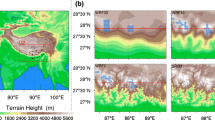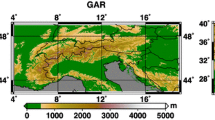Abstract
A number of studies have shown that added value is obtained by increasing the horizontal resolution of a regional climate model to capture additional fine-scale weather processes. However, the mechanisms leading to this added value are different over areas with complicated orographic features, such as the Tibetan Plateau (TP). To determine the role that horizontal resolution plays over the TP, a detailed comparison was made between the results from the REMO regional climate model at resolutions of 25 and 50 km for the period 1980–2007. The model was driven at the lateral boundaries by the European Centre for Medium-Range Weather Forecasts Interim Reanalysis data. The experiments differ only in representation of topography, all other land parameters (e.g., vegetation characteristics, soil texture) are the same. The results show that the high-resolution topography affects the regional air circulation near the ground surface around the edge of the TP, which leads to a redistribution of the transport of atmospheric water vapor, especially over the Brahmaputra and Irrawaddy valleys—the main water vapor paths for the southern TP—increasing the amount of atmospheric water vapor transported onto the TP by about 5%. This, in turn, significantly decreases the temperature at 2 m by > 1.5 °C in winter in the high-resolution simulation of the southern TP. The impact of topography on the 2 m temperature over the TP is therefore by influencing the transport of atmospheric water vapor in the main water vapor paths.


















Similar content being viewed by others
References
Asselin R (1972) Frequency filter for time integrations. Mon Wea Rev 100:487–490
Bao X, Zhang F (2013) Evaluation of NCEP-CFSR, NCEP-NCAR, ERA-Interim, and ERA-40 reanalysis datasets against independent sounding observations over the tibetan plateau. J Clim 26:206–214
Borscheid P (2015) Temporal and spatial scaling impacts on extreme precipitation. Atmos Chem Phys 15:2157–2196
Casanueva A et al (2015) Daily precipitation statistics in a EURO-CORDEX RCM ensemble: added value of raw and bias-corrected high-resolution simulations. Clim Dyn 31:1–19
Claussen M, Lohmann U, Roeckner E, Schulzweida U (1994) A global data set of land-surface parameters. MPI Report 135
Cui X, Langmann B, Graf H-F (2007) Summer monsoonal rainfall simulation on the Tibetan Plateau with a regional climate model using a one-way double-nesting system. Sola 3:49–52
Davies HC (1983) Limitations of some common lateral boundary schemes used in regional NWP models. Mon Weather Rev 111:1002–1012
Dee DP et al (2011) The ERA-Interim reanalysis: configuration and performance of the data assimilation system. Q J R Meteorol Soc 137:553–597
Eggert B, Berg P, Haerter JO, Jacob D, Moseley C (2015) Temporal and spatial scaling impacts on extreme precipitation. Atmos Chem Phys 15:5957–5971
Feng L, Zhou T (2012) Water vapor transport for summer precipitation over the Tibetan Plateau: multidata set analysis. J Geophys Res Atmos 117:20114
Gao Y, Leung LR, Zhang Y, Cuo L (2015a) Changes in moisture flux over the Tibetan Plateau during 1979–2011: insights from a high-resolution simulation. J Clim 28:4185–4197
Gao Y, Xu J, Chen D (2015b) Evaluation of WRF mesoscale climate simulations over the Tibetan Plateau during 1979–2011. J Clim 28:2823–2841
Gao Y, Xiao L, Chen D, Chen F, Xu J, Xu Y (2017) Quantification of the relative role of land-surface processes and large-scale forcing in dynamic downscaling over the tibetan plateau. Clim Dyn 48:1705–1721
Ge F, Sielmann F, Zhu X, Fraedrich K, Zhi X, Peng T, Wang L (2017) The link between Tibetan Plateau monsoon and Indian summer precipitation: a linear diagnostic perspective. Clim Dyn 49:4201–4215
Hagemann S (2002) An improved land surface parameter dataset for global and regional climate models. MPI Report 336
Hagemann S, Botzet M, Dümenil L, Machenhauer B (1999) Derivation of global GCM boundary conditions from 1 km land use satellite data. MPI Report 289
Jacob D, Podzun R (1997) Sensitivity studies with the regional climate model REMO. Meteorol Atmos Phys 63:119–129
Jacob D et al (2007) An inter-comparison of regional climate models for Europe: model performance in present-day climate. Clim Change 81:31–52
Jacob D et al (2012) Assessing the transferability of the regional climate model REMO to different coordinated regional climate downscaling experiment (CORDEX) regions. Atmosphere 3:181–199
Jacob D et al (2013) EURO-CORDEX: new high-resolution climate change projections for European impact research. Reg Environ Change 14:563–578. https://doi.org/10.1007/s10113-013-0499-2
Jacob D et al (2014) EURO-CORDEX: new high-resolution climate change projections for European impact research. Reg Environ Change 14:563–578
Ji Z, Kang S (2013) Double-nested dynamical downscaling experiments over the Tibetan Plateau and their projection of climate change under two RCP scenarios. J Atmos Sci 70:1278–1290
Kumar P, Podzun R, Hagemann S, Jacob D (2014a) Impact of modified soil thermal characteristic on the simulated monsoon climate over south Asia. J Earth Syst Sci 123:151–160
Kumar P, Sein D, Cabos W, Jacob D (2014b) Improvement of simulated monsoon precipitation over South-Asia with a regionally coupled model ROM. Int Balt Earth Secr Publ 3:16
Kumar P, Kotlarski S, Moseley C, Sieck K, Frey H, Stoffel M, Jacob D (2015) Response of Karakoram-Himalayan glaciers to climate variability and climatic change: a regional climate model assessment. Geophys Res Lett 42:1818–1825
Luca AD, Elía RD, Laprise R (2012) Potential for added value in precipitation simulated by high-resolution nested regional climate models and observations. Clim Dyn 38:1229–1247
Lucas-Picher P, Wulff-Nielsen M, Christensen JH, Mottram R, Simonsen SB (2012) Very high resolution regional climate model simulations over Greenland: identifying added value. J Geophys Res Atmos 117:262–269
Majewski D (1991) The Europa-Modell of the Deutscher Wetterdienst. ECMWF Seminar on numerical methods in atmospheric models, 1991. pp 147–191
Maussion F, Scherer D, Mölg T, Collier E, Curio J, Finkelnburg R (2014) Precipitation seasonality and variability over the Tibetan Plateau as resolved by the High Asia reanalysis. J Clim 27:1910–1927
Miliaresis GC, Argialas DP (1999) Segmentation of physiographic features from the global digital elevation model/GTOPO30. Comput Geosci 25:715–728
Molod A, Takacs L, Suarez M, Bacmeister J (2015) Development of the GEOS-5 atmospheric general circulation model: evolution from MERRA to MERRA2. Geosci Model Dev 7:1339–1356
Palazzi E, Hardenberg J, Provenzale A (2013) Precipitation in the Hindu-Kush Karakoram Himalaya: observations and future scenarios. J Geophys Res Atmos 118:85–100
Prein AF et al (2016) Precipitation in the EURO-CORDEX 0.11° and 0.44° simulations: high resolution, high benefits? Clim Dyn 46:383–412
Rasmussen R et al (2011) High resolution coupled climate-runoff simulations of seasonal snowfall over Colorado: a process study of current and warmer climate. J Clim 24:3015–3048
Rechid D, Hagemann S, Jacob D (2009a) Sensitivity of climate models to seasonal variability of snow-free land surface albedo. Theoret Appl Climatol 95:197–221
Rechid D, Raddatz TJ, Jacob D (2009b) Parameterization of snow-free land surface albedo as a function of vegetation phenology based on MODIS data and applied in climate modelling. Theor Appl Climatol 95:245–255
Redler R (2015) YAC 1.2. 0: An extendable coupling software for earth system modelling. Geoscientific Model Development
Ritter B, Geleyn J-F (1992) A comprehensive radiation scheme for numerical weather prediction models with potential applications in climate simulations. Mon Weather Rev 120:303–325
Roeckner E et al (2003) The atmospheric general circulation model ECHAM 5. PART I: Model description
Saeed F, Hagemann S, Jacob D (2009) Impact of irrigation on the South Asian summer monsoon. Geophys Res Lett 36:L20711. https://doi.org/10.1029/2009GL040625
Saeed F, Hagemann S, Jacob D (2012) A framework for the evaluation of the South Asian summer monsoon in a regional climate model applied to REMO. Int J Climatol 32:430–440. https://doi.org/10.1002/joc.2285
Sein DV, Koldunov NV, Pinto JG, Cabos W (2014) Sensitivity of simulated regional Arctic climate to the choice of coupled model domain. Tellus A 66:23966. https://doi.org/10.3402/tellusa.v66.23966
Sein DV et al (2015) Regionally coupled atmosphere-ocean-sea ice-marine biogeochemistry model ROM: 1. Description and validation. J Adv Model Earth Syst 7:268–304
Simmons AJ, Burridge DM (1981) An energy and angular-momentum conserving vertical finite-difference scheme and hybrid vertical coordinates. Mon Weather Rev 109:758–766
Su F, Duan X, Chen D, Hao Z, Cuo L (2013) Evaluation of the global climate models in the CMIP5 over the Tibetan Plateau. J Clim 26:3187–3208
Taylor KE (2001) Summarizing multiple aspects of model performance in a single diagram. J Geophys Res Atmos 106:7183–7192. https://doi.org/10.1029/2000jd900719
Tiedtke M (1989) A comprehensive mass flux scheme for cumulus parameterization in large-scale models. Mon Weather Rev 117:1779–1800
Wang QW, Tan ZM (2014) Multi-scale topographic control of southwest vortex formation in Tibetan Plateau region in an idealized simulation. J Geophys Res Atmos 119:20
Wang A, Zeng X (2012) Evaluation of multireanalysis products with in situ observations over the Tibetan Plateau. J Geophys Res Atmos 117:D05102. https://doi.org/10.1029/2011JD016553
Winiger M, Gumpert M, Yamout H (2005) Karakorum–Hindukush–western Himalaya: assessing high-altitude water resources. Hydrol Process 19:2329–2338
Wu J, Gao X (2013) A gridded daily observation dataset over China region and comparison with the other datasets. Chin J Geophy 56:1102–1111
Wu G, Guan Y, Wang T, Liu Y, Yan J, Mao J (2011) Vortex genesis over the Bay of Bengal in spring and its role in the onset of the Asian summer monsoon. Sci China Earth Sci 54:1–9
Xie SP, Xu H, Saji NH, Wang Y, Liu WT (2008) Role of narrow mountains in large-scale organization of Asian monsoon convection. J Clim 19:3420–3429
Xu X, Lu C, Shi X, Gao S (2008) World water tower: an atmospheric perspective. Geophys Res Lett 35:L20815. https://doi.org/10.1029/2008GL035867
Xu Y, Gao X, Shen Y, Xu C, Shi Y, Giorgi F (2009) A daily temperature dataset over China and its application in validating a RCM simulation. Adv Atmos Sci 26:763–772
Zhang Y, Gao H, Lammel G (2005) Simulation of monsoon seasonal variation of regional climate model REMO in East Asia (in Chinese). Clim Environ Res 10:41–55
Zhou T-j, Li Z (2002) Simulation of the East Asian summer monsoon using a variable resolution atmospheric GCM. Clim Dyn 19:167–180
Zhu X, Wang W, Fraedrich K (2013) Future climate in the Tibetan Plateau from a statistical regional climate model. J Clim 26:10125–10138
Acknowledgements
We thank anonymous reviewers for comments and suggestions that helped to improve the manuscript. Also, we are very thankful to Dr. Diana Rechid at GERICS for her discussions. This work is supported by the project “Numerical study of the surface energy and mass balance and the characteristics of boundary layer for a mountain glacier” supported by National Natural Science Foundation of China (No. 41371095), the project S1 (Climate Models as Metrics) of the Collaborative Research Centre TRR 181 Energy Transfer in Atmosphere and Ocean program funded by the German Research Foundation, EC project PRIMAVERA under the grant agreement no. 641727 and the state assignment of FASO Russia (theme No. 0149-2018-0014). We thank the MERRA for providing the high-resolution 2 m temperature and precipitation gridded data. We thank the Climate System Department at GERICS for the consultations on the REMO model. Simulations were done at the German Climate Computing Center (DKRZ). This study is also funded by “the Priority Academic Program Development of Jiangsu Higher Education Institutions” (PAPD).
Author information
Authors and Affiliations
Corresponding author
Ethics declarations
Conflict of interest
We declare that we have no conflicts of interest regarding the publication of this paper.
Additional information
This paper is a contribution to the special issue on East Asian Climate under Global Warming: Understanding and Projection, consisting of papers from the East Asian Climate (EAC) community and the 13th EAC International Workshop in Beijing, China on 24–25 March 2016, and coordinated by Jianping Li, Huang-Hsiung Hsu, Wei-Chyung Wang, Kyung-Ja Ha, Tim Li, and Akio Kitoh.
Rights and permissions
About this article
Cite this article
Xu, J., Koldunov, N., Remedio, A.R.C. et al. On the role of horizontal resolution over the Tibetan Plateau in the REMO regional climate model. Clim Dyn 51, 4525–4542 (2018). https://doi.org/10.1007/s00382-018-4085-7
Received:
Accepted:
Published:
Issue Date:
DOI: https://doi.org/10.1007/s00382-018-4085-7




